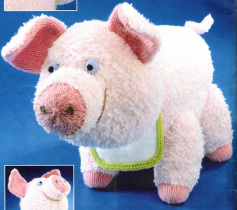I've written before about knitting where tension is not an issue. That post is here.
But there are times when tension is very important, usually garments.
My latest project is to be a fluffy pink pig based on Alan Dart's Sirdar pattern which uses predominantly snowflake DK yarn.
But there are times when tension is very important, usually garments.
My latest project is to be a fluffy pink pig based on Alan Dart's Sirdar pattern which uses predominantly snowflake DK yarn.

Now, the colour (or anything like it) has been discontinued, so an alternative is required.
I went for Sirdar's snowflake chunky instead, which is usually knitted up on 5mm needles.
An adaption of the pattern was required, especially as a plain DK yarn is also used in conjunction.
The tension for snowflake DK on 3mm needles is 26st over 36rows on a standard square, and chunky is 18st over 24rows on 4mm, a simple ratio between the two of 1.4.
Adapting the pattern meant a little maths as both width and length have to be adjusted and also allowing for shaping - sketching things out was very helpful here, especially for the turn rows shaping the top of the head.
So I now had the pattern adapted for the new yarn.
Of course, things were never going to be that easy, not knowing me!
There are TWO errors I made. It would have been a lot easier to sort out one. It would have been even easier had I knitted tension squares to begin with!
First mistake, I inadvertently knitted the snowflake on 3mm needles - I'd been using 3mm needles for just about everything for so long, it seemed natural and I didn't even realise.
Second mistake, I didn't check that the plain DK yarn I was using would knit up without distortion on 3 mm needles. It doesn't.
I went for Sirdar's snowflake chunky instead, which is usually knitted up on 5mm needles.
An adaption of the pattern was required, especially as a plain DK yarn is also used in conjunction.
The tension for snowflake DK on 3mm needles is 26st over 36rows on a standard square, and chunky is 18st over 24rows on 4mm, a simple ratio between the two of 1.4.
Adapting the pattern meant a little maths as both width and length have to be adjusted and also allowing for shaping - sketching things out was very helpful here, especially for the turn rows shaping the top of the head.
So I now had the pattern adapted for the new yarn.
Of course, things were never going to be that easy, not knowing me!
There are TWO errors I made. It would have been a lot easier to sort out one. It would have been even easier had I knitted tension squares to begin with!
First mistake, I inadvertently knitted the snowflake on 3mm needles - I'd been using 3mm needles for just about everything for so long, it seemed natural and I didn't even realise.
Second mistake, I didn't check that the plain DK yarn I was using would knit up without distortion on 3 mm needles. It doesn't.
| Initially, all looked fine, the width of the ears match. But look at the lengths. This is not right and had me checking the figures I'd used to adapt the pattern. Just by looking, it is difficult to spot the errors as there are two in play here. Now, compare the lengths with snowflake knitted on correct (4mm) needles. The measurement is taken to the first decrease of the ears. The length of the DK is actually too long, and the width is very out. Finally, using a different plain DK yarn on 3 mm needles. This alternative yarn is softer and more pliable. The length is correct and the width is correct The yarns did not knit on 3mm needles without distortion. I would have noticed this had I knitted up tension squares (and checked my needle sizes). Mea culpa. |
It would have been so much easier had I simply done this to begin with:
A very important lesson hard learned!


























 RSS Feed
RSS Feed
